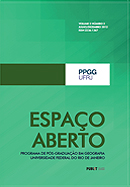Pediplanes, Pediments and Correlative Deposits in Brasil
DOI:
https://doi.org/10.36403/espacoaberto.2016.7650Keywords:
Pediplanes, Pediments, Correlative deposits, landscape evolution.Abstract
The Cenozoic history of great part of the Brazilian territory is connected with intensive erosive processes, with correlative deposition in restricted areas. The existence of three pediplanes (Pd3, Pd2 and Pd1) at different elevations and of two pediment levels (P2 and P1) inset in the valleys and in basins is conspicuous all over the surveyed area from northeastern Brazil to La Plata river. The extensive pediplane P1 inset in large basins below the summital erosion surface (usually the Pd3 or Pd2), has been considered as developed in the lower Pleistocene. The pediplanes were formed by pediplanation processes during semiarid climatic conditions. The dissection and the inlayment of the pediplanes were the result of humid climatic conditions alternating with semiarid ones. Uplift was not the only factor responsible for the development of the several erosion surfaces. Nevertheless the crustal movement contributed for higher difference in level among them. As correlative deposits of the pediplanes are referred for the Pd2, the Guararapes Formation, and for the Pd1 the Guabirotuba, Alexandra, Graxaim III, Riacho Morno and Pariquera-Açu Formations. All these formations document epochs of mechanical morphogenesis and conditions of deposition in a semiarid environment. The age of the pediplane Pd1 is considered to be Nebraskan. The pediments P2 and P1 inset in the basins are related to the Kansan and Illinoian glaciations respectively. They have been formed by parallel retreat of the slopes through processes of mechanical morphogenesis and removal and deposition of detrital material under semiarid climatic conditions. The dissection of the pediments is related to humid climatic conditions which are correlated with the interglaciais. During the Winsconsin glaciation were developed the low terrace levels with gravels. As correlative deposits of the pediments are referred the following formations: Iquererim I and II, Graxaim I and II, Pariquera-Açu I and II, as well as Canhanduva, Cachoeira and Trindade layers.
Metrics
No metrics found.


